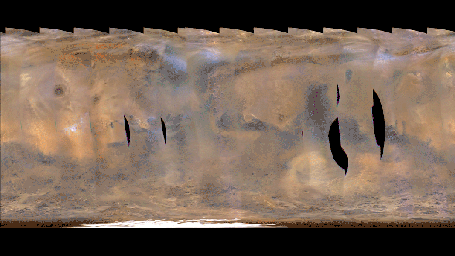
Late last week (March 9, 2017) NASA reported on two regional dust storms on Mars. The first blossomed and grew in the Acidalia area of northern Mars in February 2017 – then shifted into Mars southern hemisphere, where it’s now summer and where the storm exploded to a size bigger than the United States. That storm lasted a couple of weeks before daily global weather monitoring by NASA’s Mars Reconnaissance Orbiter showed it beginning to dissipate. Then on March 5, a second dust storm sprang up, NASA said, following the same path of origination and growth.
In fact, NASA said:
That development path is a common pattern for generating regional dust storms during spring and summer in Mars’ southern hemisphere, where it is now mid-summer.
However, according to Mars meteorologist Bruce Cantor of Malin Space Science Systems, San Diego, which built and operates the orbiter’s wide-angle Mars Color Imager (MARCI):
What’s unusual is we’re seeing a second one so soon after the first one. We’ve had orbiters watching weather patterns on Mars continuously for nearly two decades now, and many patterns are getting predictable, but just when we think we have Mars figured out, it throws us another surprise.
There’s still a chance the second one could become a planet-encircling storm, but it’s unlikely because we’re getting so late in the season.
All previously observed planet-encircling dust storms on Mars occurred earlier in the southern summer.
Click here for weekly Martian weather reports including animated sequences of MARCI observations

Exactly as portrayed in the popular movie The Martian, dust storms decrease sunlight to the surface and have the potential to interfere with the operataion of Mars rovers. MARCI weather reports help rover teams protect their vehicles. For example, NASA explained, the warning about a regional storm approaching the rover Spirit in November 2008 prompted JPL to send an emergency weekend command to conserve energy by deleting a planned radio transmission. That saved enough charge in Spirit’s batteries to prevent what Opportunity Project Manager John Callas, at JPL described as:
… likely a very serious situation.
NASA said that, during the most recent global dust storm on Mars, in 2007, both of the rovers then operating on the planet — Spirit and Opportunity — were put into a power-saving mode for more than a week with minimal communication (the early-2010 ending of Spirit’s mission was not related to a dust storm). But, NASA also said:
The same winds that raise Martian dust into the atmosphere can clear some of the dust that accumulates on the rovers. On February 25, as the first back-to-back was spreading regionally, Opportunity experienced a significant cleaning of its solar panels that increased their energy output by more than 10 percent, adjusted for the clarity of the atmosphere. Dust-removing events typically clean the panels by only one or two percent. The Opportunity operations team has noticed over the years that a large dust-cleaning event often precedes dusty skies.
Since February 25, the atmosphere over Opportunity has become dustier, and some of the dust has already fallen back onto the solar panels.
JPL rover-power engineer Jennifer Herman said:
Before the first regional dust storm, the solar panels were cleaner than they were during the last four Martian summers, so the panels generated more energy. It remains to be seen whether the outcome of these storms will be a cleaner or dirtier Opportunity.
NASA’s Curiosity rover, on Mars since 2012, uses a radioisotope thermoelectric generator for power instead of solar panels, so it doesn’t face the same hazard from dust storms as Opportunity does. But NASA is hoping to use both rovers to observe the growth and life cycle of a regional or global storm. That’s why scientists temporarily modified Curiosity’s weather-monitoring regime last week in response to learning that a regional dust storm was growing. Mars atmospheric scientist Mark Lemmon of Texas A&M University, College Station said:
We’ll keep studying this for weeks as the dust clears from the sky.
Bottom line: In February and March 2017, the Mars Reconnaissance Orbiter has reported two dust storms that sprang up in Mars northern hemisphere, then exploded to continent-size upon shifting southward.











